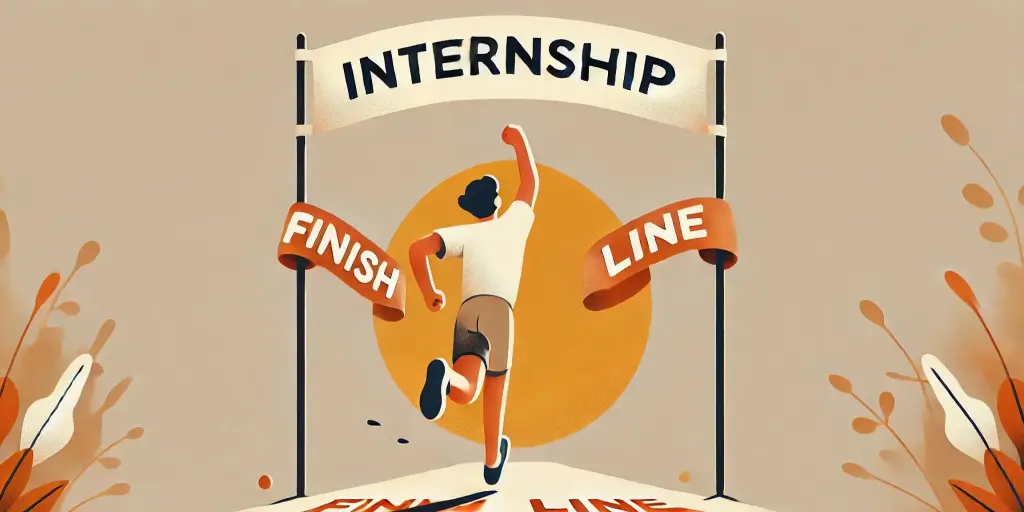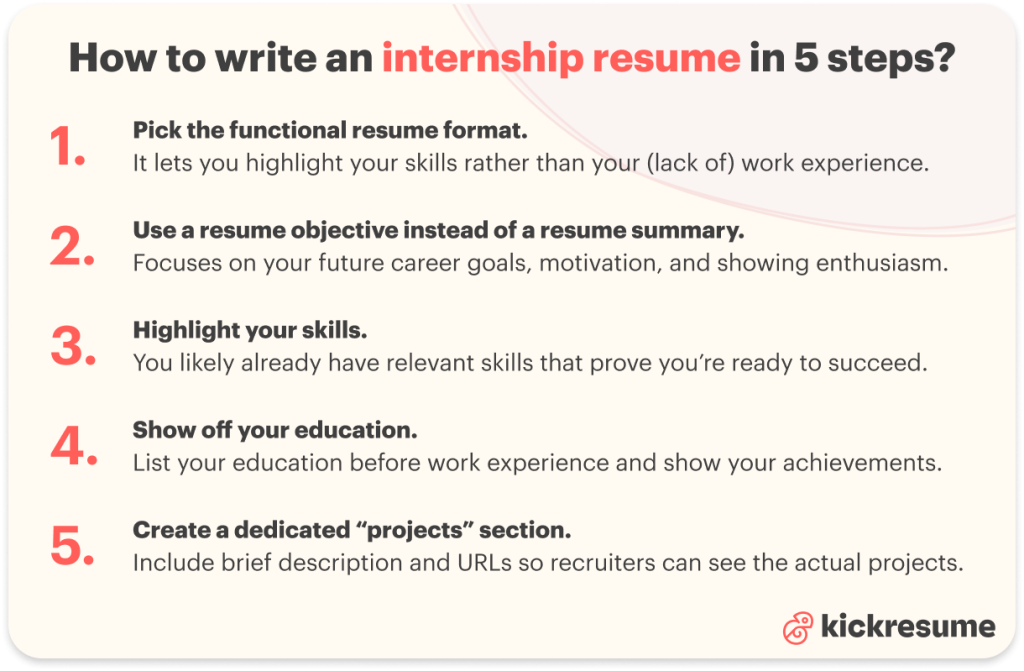Thinking about applying for an internship but not sure where to begin? Well, your first step is creating a standout internship resume that grabs attention.
But then you might think, “I don’t have any work experience yet—how can I make my resume strong?”
Don’t worry—we’ve got you covered! We’ll show you exactly how to highlight your skills and extracurriculars to build an impressive internship resume, even if you’ve never had a job before.
Plus, we'll show you 3 internship resume examples you can use as your first draft or simply get inspired by.
What is a resume for an internship?
Unlike a typical resume used for regular job applications, which focuses mainly on your work experience, an internship resume (a.k.a. a resume you'd use to apply for internships) should focus on showcasing your skills, education, and extracurricular activities.
Essentially, it’s just like a regular resume, but it highlights different sections, since you likely don’t have much work experience yet.
Employers don’t expect a long list of past jobs, since internships are often the first step in your career.
Instead, they’re looking for potential, enthusiasm, and a willingness to learn. Which is what your internship resume needs to reflect.
How to write a resume for an internship?
If you're struggling with creating your internship resume, we've broken it down into 5 simple steps. With these steps, you can build an impressive resume for an internship—even if you've never had a job before.
- Pick a functional resume format.
Instead of using the classic reverse-chronological resume format, which primarily highlights your work experience, go with a functional resume format, which lets you highlight your soft and hard skills (and steer attention away from your lack of work experience.)
- Use a resume objective instead of a resume summary.
Similarly, instead of choosing to write a resume summary on the top of your resume, go for a resume objective. It's not heavy on your work history and achievements but rather focuses on your future career goals, your motivation, and showing your enthusiasm. Which is what the recruiters are looking for.
- Highlight your skills.
When applying for an internship, you might not have much work experience yet. But what you do have are valuable skills—whether from school projects, courses, or extracurricular activities. Be sure to put those front and center on your resume!
- Show off your education.
As a student or recent graduate, your education is probably your strongest asset. Make it a priority by listing it before your work experience. Make sure to highlight your academic achievements, projects, relevant courses, and even your thesis if it's relevant to the internship.
- Create a dedicated “projects” section.
Including a separate projects section in a resume isn't common, but it can be a game-changer. It provides tangible proof of your skills and demonstrates your proactiveness. List your academic projects, GitHub contributions, or freelance projects. Be sure to include URL links to your projects—that way you're showing concrete examples instead of just listing them on paper.
Choosing the right resume format is your first task. The format decides what section of your resume will stand out, based on how you order them.
If you don’t have a lot of work experience, picking a format that focuses mostly on your work history (like the reverse-chronological format) might not be the best option.
Here are the three most popular resume formats:
- Reverse-chronological. Focuses on your job history, listing your most recent job first. This is great for seasoned professionals who already have tons of experience.
- Functional (also called skills-based resume). This format emphasizes your skills over work experience, making it perfect for interns and students. It answers the question “What can you do?” rather than “Show me where you worked.”
- Hybrid. A balanced mix of work experience and skills. It’s a good option if you have some experience but want to highlight your skills too.
Since internships are often for students or people without much experience, the functional format is definitely the best choice.
Step 2: Use a resume objective instead of a resume summary
A key part of any resume is a brief statement at the top, known as a resume summary or resume objective. Although these terms are often used interchangeably, a resume objective is not the same as a resume summary!
What's the difference between a resume summary and a resume objective?
- Resume summary. It's looking at the past–focuses on highlighting your experience, skills, and achievements to show why you're a great fit for the job. It’s often used by candidates with more experience to showcase what they bring to the role.
- Resume objective. It's looking at the future–focusing on your career goals and what you hope to achieve in the job you're applying for. It’s a great choice for interns, students, and first-time job seekers, as it shows enthusiasm for the role.
Naturally, then, our advice is to go with a resume objective. Highlight your career aspirations and explain how this opportunity aligns with your goals.
Use this section to show the employer why this internship is the perfect next step for you.
And if you're still not sure how to write a resume objective, check out our guide for helpful tips and examples.
Step 3: Highlight your skills
When applying for an internship, your skills are your biggest advantage.
Why?
Most interns don’t have much work experience yet, but that doesn’t mean you lack the qualifications. You likely already have relevant skills that prove you’re ready to succeed, even as an intern.
Think about the projects you completed in university, the courses you took, and the tools or software you learned to use.
Beyond that, you might have experience from volunteer work, part-time jobs, or leadership roles in clubs. All of these experiences demonstrate valuable skills that can set you apart—so make sure to highlight them!
For the most impact, divide your skills into:
- Hard skills. These are technical abilities and knowledge from studies (specific computer skills like programming languages). Try to be as specific as possible for the internship you're applying for, as recruiters often look for them when looking for interns.
- Soft skills. These skills are more part of your personality. It shows your abilities to work with others, and ability to adapt to different situations. These include skills like communication skills, problem-solving, and teamwork.
To make the skills section even more engaging, organize your skills into more relevant categories such as programming languages, languages, or soft skills.
Aim to include 10–15 key skills that show you have the potential to succeed in the role.
Step 4: Show off your education
Your education is your second biggest asset as an aspiring intern, so don’t be afraid to use it to your advantage.
Don't just include your school, degree, and graduation date. Go a step further and consider including also:
- Relevant coursework
- GPA (if higher than 3.5)
- Awards (Dean’s list, magna cum laude, subject-based awards)
- Scholarships
- Relevant student societies (especially if you were in the committee and played an active role)
- Academic publications
- Studying abroad
- Internships
- Thesis name and description
Think of your education as more than just a list. Highlight what’s most relevant to the internship you're applying for.
If you were part of any projects or student organizations that taught you valuable skills, mention those too!
Step 5: Create a dedicated “projects” section
Projects on resume aren't super common yet, which is why it can really help your resume stand out.
This is basically a section where you list any independent projects you did. These can be:
- Personal project, like a personal blog, a website or an app you created, or a graphic design portfolio.
- Academic projects, like research papers, group projects, case studies, or presentations you completed as part of your coursework.
- Freelance projects, like managing a social media campaign for a small business, writing content for a website, or crafting logo designs and other branding materials for clients.
- Programming projects, like coding a game, building a data analysis tool, or contributing to open-source software on GitHub.
For each project, include a brief description outlining your role, the skills you used, and, most importantly, a URL link so that recruiters can see the actual work or results.
Employers will love this because it's a tangible proof of your skills and it demonstrates your proactiveness, interest, and initiative.
And, If you want to go the extra mile, consider adding optional sections like:
- Volunteering
- References
- Courses
- Certifications
- GitHub contributions
- Awards and achievements
Internship resume examples
Now, it's time to look at 3 internship resume examples that helped real people secure internships.
You can use them for inspiration or even use them as your first draft.
PS: Some of these resumes are longer than one page. To see the full version of the resumes, click directly on the image.
Want to see even more internship resume examples? Check out our resume database where you'll find more internship resume examples belonging to real people who secured internships at companies like Cisco, Intel, Payworks, NBC, or Philips.
Simply filter by the keyword "intern" in the search bar.
A final hack to secure an internship: Cover letter
If you're applying for an internship there is a big chance you'll have to create a an internship cover letter to go with your resume, too.
An internship cover letter is a formal document that accompanies your resume when applying for an internship.
When it comes to its content, a cover letter for an internship falls somewhere between a traditional cover letter and a motivational letter.
What is the difference between a cover letter and a motivation letter?
- Cover letter. This document accompanies your resume and is tailored to a specific job posting. It explains why you're interested in the job and why you're a good fit, focusing on your accomplishments, skills, and experience.
- Motivation letter. This is more general and often used for academic programs or volunteer opportunities. It explains why you're applying for a specific program, focusing on your passions and goals, and how the opportunity will help you achieve them.
An internship cover letter combines elements of both—a cover letter (showing why you’re a good fit for the role) and a motivation letter (sharing your personal motivations and goals).
However, a good internship cover letter should address a few key points, such as:
- Who you are
- Why you’re interested in the internship
- Why you’re the best fit for the company
- What you hope to gain from this internship
Want to see some examples? You'll find 5 internship cover letter examples belonging to real people in this article: How to Write a Cover Letter for an Internship? (+5 Real Internship Cover Letter Examples)
How to put internship on resume?
Say you’ve already done an internship, or maybe even a few, and now you're applying for a new job. Should you include them on your resume?
The first question to ask is: Is the internship relevant to the job?
- If the answer is no, it depends on the rest of your resume.
- But if the answer is yes, then absolutely include it.
Now, where should it go on your resume?
Consider creating a separate section called Projects and Internships where you can highlight all the key projects you’ve worked on or internships you’ve completed.
Alternatively, you can include your internship in the work experience section, making sure to list your role as "Intern" to clearly show it's an internship, not a full-time job.
Key takeaways: Internship resume
So, how do you write a strong internship resume? Let’s break it down.
Since inspiring interns often don’t have much work experience, crafting a solid internship resume is a bit different and needs to focus on other aspects, rather than just work experience.
To create a successful internship resume, follow these 5 steps:
- Pick a functional resume format.
- Use a resume objective instead of a resume summary.
- Highlight your skills.
- Show off your education.
- Create a dedicated “projects” section.
Remember, this resume is your chance to show your potential and your motivation, rather than extensive work history.







